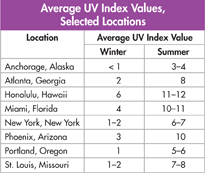Think Critically
Infer A skin callus is a thickening of the epidermis caused by repeated rubbing. Why do people often get calluses on their feet?
Predict As people age, the rate at which new skin cells are produced slows down, but the rate at which skin cells are shed does not. What effect do you think this has on a person's skin?
Relate Cause and Effect People with albinism have little pigment in their skin, hair, or eyes. Albinism is usually a genetically recessive disease that inhibits cells from producing a particular chemical. What chemical do you think is lacking in people with albinism? Explain.
Connecting Concepts
Use Science Graphics
Infer Because cartilage does not appear on X-ray film, it is seen as a clear area between the shaft and the ends of bones. Examine the X-rays. Which hand belongs to the youngest person? Explain.

Write About Science
Explanation Severe burns of large areas of the skin can be a life-threatening injury. Develop a paragraph that explains the greatest risks these burn patients face.
Compare and Contrast Support and movement are the basic functions of the skeletal, muscular, and integumentary systems. In a paragraph, compare these three body systems with similar structures of a building. For example, which body system has the same function as the girders of a building? Of the walls? How are they similar? How are they different? (Hint: To get started, you may want to list shared characteristics.)
Assess the
 Recall what you learned about the bones of fishes, amphibians, reptiles, birds, and mammals. Compare examples of specific skeletal parts, such as backbones or forelimbs. Relate the bones to the way each animal moves.
Recall what you learned about the bones of fishes, amphibians, reptiles, birds, and mammals. Compare examples of specific skeletal parts, such as backbones or forelimbs. Relate the bones to the way each animal moves.
Analyzing Data
The UV (ultraviolet) index is a rating system developed by the Environmental Protection Agency. The goal of the index is to inform the public about the level of UV radiation to expect on a given day. Higher numbers indicate higher levels of UV radiation. The table shows the average UV indexes for various cities in the United States.
Interpret Data A person visiting which of the following cities would need to be the most careful about his or her level of sun exposure?
Honolulu in winter
Anchorage in summer
Atlanta in winter
St. Louis in summer
Form a Hypothesis Develop a hypothesis that could explain the relationship between geography and average UV index values.
Table of Contents
- Formulas and Equations
- Applying Formulas and Equations
- Mean, Median, and Mode
- Estimation
- Using Measurements in Calculations
- Effects of Measurement Errors
- Accuracy
- Precision
- Comparing Accuracy and Precision
- Significant Figures
- Calculating With Significant Figures
- Scientific Notation
- Calculating With Scientific Notation
- Dimensional Analysis
- Applying Dimensional Analysis





